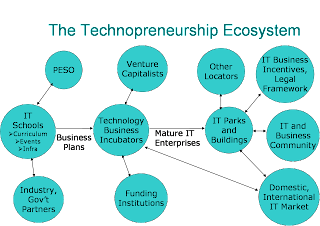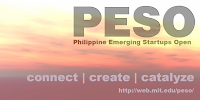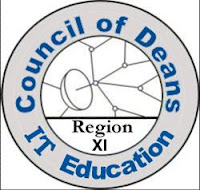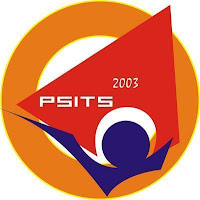
My past posts in this blog have been dominantly on technopreneurship and IT education. A lot of ideas and experiential learnings on these two areas have been "pushed" down my "knowledge stack" and they seem to be crying out for expression -- to be "popped" out, so to speak. Pardon my analogy to the stack data structure, but I hope you don't mind the "popping" streak I'm having regarding these two very much related themes. This post explores on the tight relationship between technopreneurship and IT education. I already shared these thoughts in many occasions through presentation slides and I wish to put them down in narrative form in two parts. This post is the first part...
A Default Mindset
"Go to school, get good grades, land in a high-paying job." This is the usual mindset that most people have about formal education. Parents send their children to school with this mindset. Students imbibe this mindset and carry it with them until college. Most schools subscribe to and support this mindset. It is like a default mindset. We can formally call it the employment mindset.
The results of the employment mindset can be beneficial or destructive, depending on one's perspective. From the perspective of schools subscribing to this mindset, they take pride in the fact that their best graduates are sought after by companies, offering them attractive compensation packages. In the case of Davao schools, the best graduates are lured to companies in Manila, Cebu, and other prosperous urban cities. The average graduates try to remain in Davao but find it hard to land in good-paying jobs and find themselves following the route of their better classmates. Schools beam with pride when they get feedback that their graduates excel in the companies they are working for. However, I cannot help but be disturbed by this following reality check. Our best graduates help in the development of other places, not Davao -- and they have reservations in coming back. This "brain drain" cycle happens yearly and Davao's industries remain thin and their development snail-paced. With this yearly exodus of our best minds to other places, will we allow Davao to remain as a sought-after human resource provider forever? This reminds me of a local saying, "tayo ang nagsaing, iba ang kumain." I guess there has to be an end to this yearly phenomenon.
An Alternative Mindset
"Go to school, get good grades, create and own a company."
"Use your knowledge, skills, core values, creativity and passion to create and innovate through technology."
"Contribute and be involved in the technological development of Davao."
These statements offer an alternative mindset. We can formally call it the technopreneurship mindset. Technopreneurship is entrepreneurship in the field of high technology. It is the healthy interplay of technology ideas, technology skills, management skills and the entrepreneurial mindset. It starts with an idea, which when pursued, has the capacity to be transformed into a viable technology-based enterprise. The cultivation and nurturing of this alternative mindset can start in schools. A technopreneurship track in the IT curriculum can prepare students to be budding technopreneurs.
A technopreneurship track in the IT curriculum of Davao schools can lead to the following scenario... Our graduates decide to pursue their technoology-based business plans as start-ups in technology-business incubators. Venture capitalists invest in their viable high technology product(s). Their start-ups mature into stable IT enterprises and eventually locate in IT parks or buildings. The IT enterprises compete in the domestic and global market and spur economic growth in the locality. The local IT industry blossoms and attracts more locators and investors. Our graduates decide to build their careers and families in Davao. Graduates who left Davao return and decide to take root here. Davao becomes the IT hub and capital of Mindanao -- and possibly the Philippines, BIMP-EAGA, or even the Asia Pacific Region. Davao becomes the home of highly competent and efficient IT professionals with sound social and ethical standards. The Davao schools become renowned worldwide for producing such graduates.
The Macro Strategy
To attain and sustain the healthy scenario described above, a technopreneurship ecosystem in the region has to be in place. This requires the synergy of the academe, IT industry, government, and business community. This so-called synergy is sustained with the following components: (1) technopreneurship programs in the academe; (2) technology-business incubators; (3) venture capitalists and funding insitutions; (4) IT business incentives and a supportive legal framework; (5) IT parks and buildings; (6) access to domestic and international IT market; (7) domestic and international locators; (8) IT-enabled business enterprises and government agencies; (9) IT-enabled hotels and tourist destinations; (10) IT-friendly real estate environment.
This synergy scenario is still far from reality but a lot of inroads have already been achieved towards this direction. We have an active IT academic community with the presence of PSITE-XI, CDITE-XI and PSITS-XI. Twelve schools as of the moment have committed to implement a technoproneurship course in their IT education programs. The IT industry is now in good hands with ICT Davao, Inc., the umbrella organization of all IT organizations in Davao. To date, there are 10 IT organizations coming from distinct subsectors under its wing. We have quite a number of supportive City Councilors from the Davao City Council. A number of resolutions and ordinances in support of the IT industry have been passed by these supportive councilors. An IT Committee was created during the previous City Council to respond to the needs of the IT industry. We also have a supportive business community in the Davao City Chamber of Commerce and Industry, Inc. (DCCCII). Quite a number of initiatives and programs in support of the IT industry have emanated from the Chamber. To date, we have one IT incubation center in the campus of the Brokenshire College. We also have one IT Park at the Damosa property while NCCC Mall is preparing their fourth floor to be an IT Zone. We also have a lot of establishments providing free wi-fi access to customers. A number of locators have already set up camp in the city and there are others following soon. Things seem to be falling in the right place but the big challenge is how to sustain the emerging synergy and eventually maintain the ecosystem.













